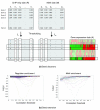Inferring transcriptional modules from ChIP-chip, motif and microarray data
- PMID: 16677396
- PMCID: PMC1779513
- DOI: 10.1186/gb-2006-7-5-r37
Inferring transcriptional modules from ChIP-chip, motif and microarray data
Abstract
'ReMoDiscovery' is an intuitive algorithm to correlate regulatory programs with regulators and corresponding motifs to a set of co-expressed genes. It exploits in a concurrent way three independent data sources: ChIP-chip data, motif information and gene expression profiles. When compared to published module discovery algorithms, ReMoDiscovery is fast and easily tunable. We evaluated our method on yeast data, where it was shown to generate biologically meaningful findings and allowed the prediction of potential novel roles of transcriptional regulators.
Figures



Similar articles
-
Discovering transcriptional modules from motif, chip-chip and microarray data.Pac Symp Biocomput. 2005:483-94. Pac Symp Biocomput. 2005. PMID: 15759653
-
Combining sequence and time series expression data to learn transcriptional modules.IEEE/ACM Trans Comput Biol Bioinform. 2005 Jul-Sep;2(3):194-202. doi: 10.1109/TCBB.2005.34. IEEE/ACM Trans Comput Biol Bioinform. 2005. PMID: 17044183
-
CAGER: classification analysis of gene expression regulation using multiple information sources.BMC Bioinformatics. 2005 May 12;6:114. doi: 10.1186/1471-2105-6-114. BMC Bioinformatics. 2005. PMID: 15890068 Free PMC article.
-
An algorithmic perspective of de novo cis-regulatory motif finding based on ChIP-seq data.Brief Bioinform. 2018 Sep 28;19(5):1069-1081. doi: 10.1093/bib/bbx026. Brief Bioinform. 2018. PMID: 28334268 Review.
-
Transcriptional regulatory networks and the yeast cell cycle.Curr Opin Cell Biol. 2002 Dec;14(6):676-83. doi: 10.1016/s0955-0674(02)00391-5. Curr Opin Cell Biol. 2002. PMID: 12473339 Review.
Cited by
-
Inferring Transcriptional Interactions by the Optimal Integration of ChIP-chip and Knock-out Data.Bioinform Biol Insights. 2009 Oct 21;3:129-40. doi: 10.4137/bbi.s3445. Bioinform Biol Insights. 2009. PMID: 20140075 Free PMC article.
-
Inference of hierarchical regulatory network of estrogen-dependent breast cancer through ChIP-based data.BMC Syst Biol. 2010 Dec 17;4:170. doi: 10.1186/1752-0509-4-170. BMC Syst Biol. 2010. PMID: 21167036 Free PMC article.
-
Gene regulatory pattern analysis reveals essential role of core transcriptional factors' activation in triple-negative breast cancer.Oncotarget. 2017 Mar 28;8(13):21938-21953. doi: 10.18632/oncotarget.15749. Oncotarget. 2017. PMID: 28423538 Free PMC article.
-
DISTILLER: a data integration framework to reveal condition dependency of complex regulons in Escherichia coli.Genome Biol. 2009;10(3):R27. doi: 10.1186/gb-2009-10-3-r27. Epub 2009 Mar 6. Genome Biol. 2009. PMID: 19265557 Free PMC article.
-
PyPanda: a Python package for gene regulatory network reconstruction.Bioinformatics. 2016 Nov 1;32(21):3363-3365. doi: 10.1093/bioinformatics/btw422. Epub 2016 Jul 10. Bioinformatics. 2016. PMID: 27402905 Free PMC article.
References
-
- Segal E, Shapira M, Regev A, Pe'er D, Botstein D, Koller D, Friedman N. Module networks: identifying regulatory modules and their condition-specific regulators from gene expression data. Nat Genet. 2003;34:166–176. - PubMed
-
- Van den Bulcke T, Lemmens K, Van de Peer Y, Marchal K. Inferring transcriptional networks by mining 'omics' data. Current Bioinformatics.
Publication types
MeSH terms
Substances
LinkOut - more resources
Full Text Sources
Molecular Biology Databases

